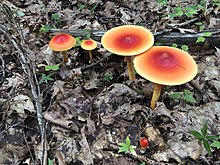Amanita jacksonii, also known as Jackson's slender amanita,[2] American Slender Caesar, and Eastern Caesar's Amanita,[3] is a North American species of fungus in the family Amanitaceae. It is a reddish-orange colored mushroom species which can be identified by its yellow gills, large, white, sacklike volva.[4]
| Amanita jacksonii | |
|---|---|

| |
| A. Jacksonii in Maine, USA, July 2021. | |
| Scientific classification | |
| Domain: | Eukaryota |
| Kingdom: | Fungi |
| Division: | Basidiomycota |
| Class: | Agaricomycetes |
| Order: | Agaricales |
| Family: | Amanitaceae |
| Genus: | Amanita |
| Species: | A. jacksonii
|
| Binomial name | |
| Amanita jacksonii | |
| Synonyms[1] | |
|
Amanita umbonata Pomerl. | |
| Amanita jacksonii | |
|---|---|
| Gills on hymenium | |
| Cap is flat or convex | |
| Hymenium is free | |
| Stipe has a ring and volva | |
| Spore print is white | |
| Ecology is mycorrhizal | |
| Edibility is choice but not recommended | |


Taxonomy
editIt was given its current name in 1984 by Canadian mycologist René Pomerleau.[5]
Description
editThe cap of the mushroom is 8–12 centimetres (3–4+1⁄2 inches) wide; oval at first, becoming convex, typically with a central bump; sticky; brilliant red or orange, fading to yellow on the margin; typically without warts or patches; the margin lined for about 40–50% of the cap's radius. The red pigment fades from margin toward the center with age.[6] Gills are moderately crowded to crowded, orange-yellow to yellow-orange to yellow. They are free from the stem or slightly attached to it; yellow to orange-yellow; crowded; not bruising. The short gills are subtruncate to truncate. Its stipe measures 90–140 by 9–16 millimetres (3+1⁄2 in–5+1⁄2 in × 1⁄4 in–3⁄4 in), is yellow and decorated with orange fibrils and patches that are the remnants of a felted extension of the limbus internus of the otherwise white volva. The spores measure (7.0-) 7.8–9.8 (-12.1) × (5.2-) 5.8–7.5 (-8.7) μm and are broadly ellipsoid to ellipsoid (rarely subglobose or elongate) and inamyloid. Clamps are common at bases of basidia.[7] The flesh looks whitish to pale yellow, and does not stain on exposure.
Similar species
editA. jacksonii looks similar to A. caesarea (Caesar's mushroom), which is found in Europe and North Africa, as well as poisonous species of Amanita.
Distribution and habitat
editIts range extends from the Province of Quebec, Canada, to at least the State of Hidalgo, Mexico.[8]
Uses
editThe mushroom is considered a choice edible, although it can be misidentified with toxic species such as A. muscaria and A. phalloides.[9]
See also
editReferences
edit- ^ "Amanita jacksonii - Amanitaceae.org - Taxonomy and Morphology of Amanita and Limacella". www.amanitaceae.org. Retrieved 21 September 2017.
- ^ "Standardized Common Names for Wild Species in Canada". National General Status Working Group. 2020.
- ^ https://plants.ces.ncsu.edu/plants/amanita-jacksonii/ accessed Aug. 2021
- ^ Kuo, M. (2008, March). Amanita jacksonii. Retrieved from the MushroomExpert.Com Web site: http://www.mushroomexpert.com/amanita_jacksonii.html
- ^ Pomerleau R. (1984). "A propos du nom scientifique de l'oronge américaine". Naturaliste Canadien (in French). 111 (3): 329–30.
- ^ http://www.eticomm.net/~ret/amanita/species/jacksoni.html Archived 2011-07-16 at the Wayback Machine By R. E. Tulloss.
- ^ http://www.amanitaceae.org/index.php?Amanita%20jacksonii Amanita jacksonii-www.amanitaceae.org
- ^ Mushroom Observer-Amanita jacksonii Pomerleau https://mushroomobserver.org/name/show_name?_js=on&_new=true&id=1067
- ^ Davis, R. Michael; Sommer, Robert; Menge, John A. (2012). Field Guide to Mushrooms of Western North America. Berkeley: University of California Press. pp. 70–71. ISBN 978-0-520-95360-4. OCLC 797915861.